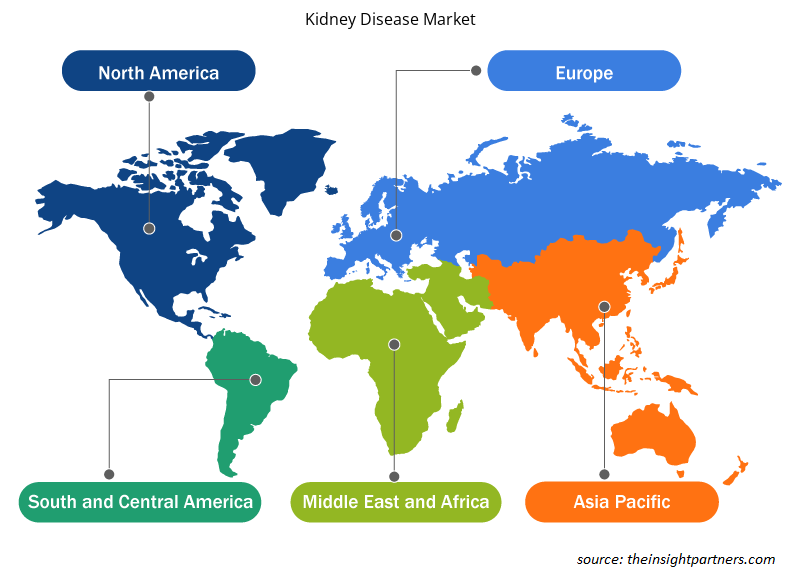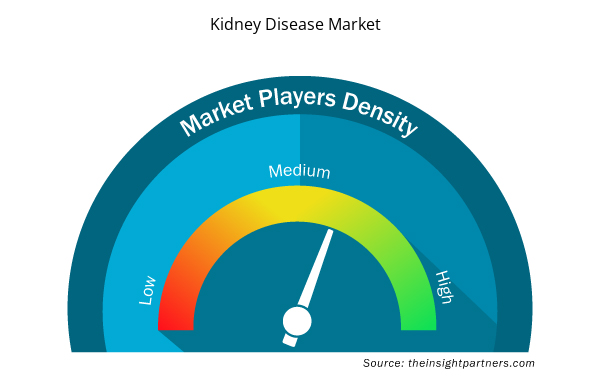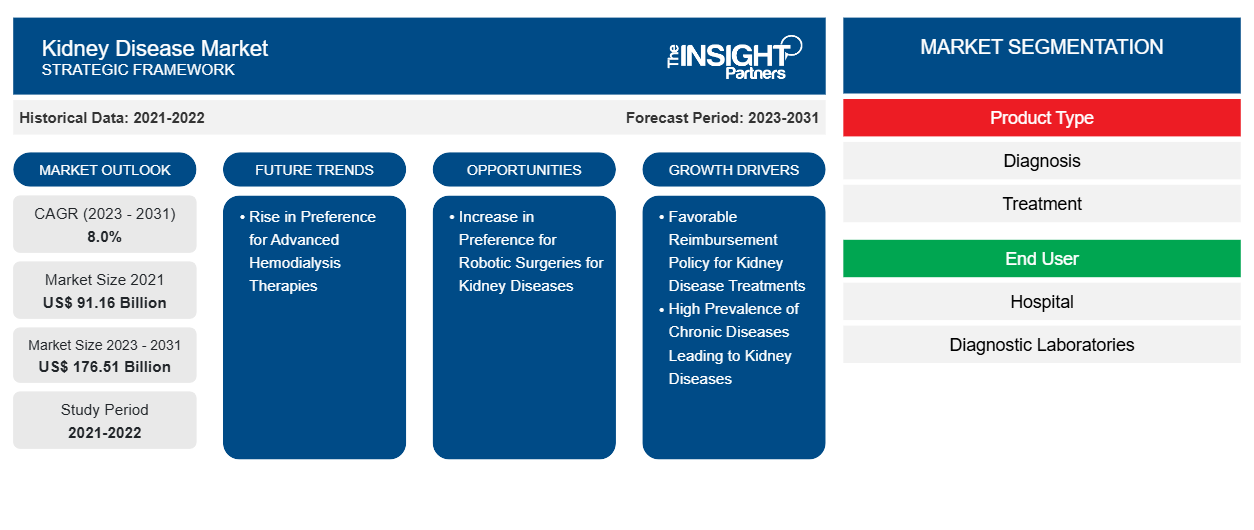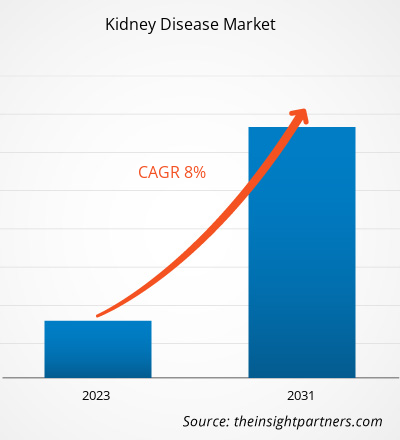腎臓病の市場規模は、2021年には911.6億米ドル、2023年にはXX億米ドルと推定され、2031年までに1,765.1億米ドルに達すると予想されており、2023年から2031年にかけて8.0%のCAGRを記録すると予測されています。
消費者主導で安全性を重視する新製品は、腎臓病の罹患率の上昇と、自宅で治療を受けることを望む高齢患者の増加によって推進されてきました。このような先進的な治療の代替手段は、腎臓病市場の主要トレンドであり続けると思われます。
腎臓病市場分析
慢性腎臓病(CKD)は、世界中で10人に1人が罹患する一般的な生命を脅かす病気です。高血圧と糖尿病は、CKDの全症例の3分の2を占めています。さらに、国立腎臓財団が発表した研究によると、2020年には、20歳以上の糖尿病患者の約35%が、その期間に慢性腎臓病を発症するとされています。さらに、世界保健機関は、重要医薬品リストの概念やユニバーサルヘルスカバレッジ(UHC)アプローチなど、政策立案者の政策を維持するためのさまざまな戦略を概説しました。さらに、生活費の高騰に伴い、在宅透析治療では光熱費の償還が不可欠です。欧州諸国は、さまざまな重要な医薬品を無償または割引価格で提供することを目的とした償還システムを開発しました。たとえば、2024年2月、スコットランド政府は、Kidney Care UKのキャンペーンを受けて、スコットランドの在宅透析患者に対する償還に関する初の国家ガイドラインを導入しました。また、ウェールズでは、あらゆる形態の在宅透析に対して払い戻しが行われています。これらの要因により、予測期間中に市場の成長が促進されると予想されます。
腎臓病市場の概要
CKDでは、腎臓が損傷して血液をろ過できず、体内の血液から余分な水分と老廃物が生じ、心臓病や脳卒中などの他の健康問題を引き起こします。米国疾病管理予防センター(CDC)は、米国の成人の7人に1人以上、約3,550万人、つまり14%がCKDを患っていると述べています。成人の10人中9人はCKDにかかっていることに気づいておらず、重度のCKDを患う成人の3人に1人はCKDにかかっていることに気付いていません。市場のもう1つの主な推進力は、高齢化が腎疾患の発生率増加の危険因子であるため、高齢者人口の増加です。たとえば、2024年にPopulation Reference Bureau(PRB)が発表した調査によると、65歳以上のアメリカ人は2022年の5,800万人から2050年までに8,200万人に増加し、47%増加し、総人口の割合は17%から23%に増加すると予測されています。米国政府からの継続的な支援は、米国で有利な機会をもたらすでしょう。たとえば、2024 年 2 月、Simple HealthKit は健康保険をサポートする新しい腎臓ケア プログラムを開始しました。このプログラムは早期発見を提供し、患者の転帰を改善し、治療費を大幅に削減します。Simple HealthKit は、既存のサービスで民間および政府の健康保険と提携し、アクセスが困難なメンバーに接続するために展開できるカスタム テスト プログラムを設計するために協力しています。
要件に合わせてレポートをカスタマイズする
このレポートの一部、国レベルの分析、Excelデータパックなど、あらゆるレポートを無料でカスタマイズできます。また、スタートアップや大学向けのお得なオファーや割引もご利用いただけます。
- このレポートの主要な市場動向を入手してください。この無料サンプルには、市場動向から見積もりや予測に至るまでのデータ分析が含まれます。
腎臓病市場の推進要因と機会
腎臓病につながる慢性疾患の有病率の高さが市場を有利に導く
慢性腎臓病は腎機能を低下させ、腎臓に損傷を引き起こします。慢性腎臓病を引き起こす疾患や症状には、糖尿病や高血圧などがあります。国立医学図書館(NLM)で公開されたレポートによると、世界の糖尿病の負担の約80%は低・中所得国によるもので、症例の60%はアジアにあります。つまり、糖尿病の有病率が最も高い10カ国のうち6カ国はアジアにあります。世界経済フォーラムによると、中国は世界で最も糖尿病の発生率が高い国の一つであり、悪化し続けています。中国では、2021年には国内に推定1億4100万人の糖尿病患者がおり、20〜79歳の成人の有病率は2020〜2030年の間に8.2%から9.7%に増加すると予測されています。
腎臓疾患に対するロボット手術の好感度上昇 - チャンス
全米腎臓財団によると、腎臓疾患は腎臓がんのリスクが高く、慢性腎臓病 (CKD) 患者の死亡原因の第 2 位となっています。腫瘍を正確に切除するために、ロボットによる部分腎切除術のアプローチを使用して、腎臓の健全で機能的な部分をそのまま維持します。また、FAST ロボットによる部分腎切除術は、腎臓腫瘍を外科的に切除し、腎臓を再建して機能障害を防ぐ強化されたアプローチです。北米、ヨーロッパ、アジアのさまざまな国で、手術におけるロボットの採用が大幅に増加しています。
腎臓病市場レポートのセグメンテーション分析
腎臓病市場分析の導出に貢献した主要なセグメントは、製品タイプとエンドユーザーです。
- 製品タイプに基づいて、腎臓病市場は診断と治療に分かれています。診断セグメントは、血液検査、尿検査、画像検査などに細分化されています。治療セグメントは、薬物クラス、透析などにさらに細分化されています。診断セグメントは、2023年に大きな市場シェアを占めました。
- エンドユーザー別に見ると、市場は診断ラボ、病院、その他に分類されます。病院セグメントは2023年に市場で最大のシェアを占めました。
腎臓病の市場シェア分析(地域別)
腎臓病市場レポートの地理的範囲は、主に北米、アジア太平洋、ヨーロッパ、中東およびアフリカ、南米/中南米の 5 つの地域に分かれています。
腎臓病市場は北米が独占しています。米国では、成人の約 15% が慢性腎臓病を患っています。米国では約 3,700 万人が慢性腎臓病を患っています。北米は 2022 年に最大のシェアを占めました。この地域での CKD の発生率の上昇と世界的な市場プレーヤーの存在が、北米の腎臓病市場の独占に寄与する要因となっています。今後数年間、アジア太平洋地域は最高の CAGR で成長すると予想されています。
腎臓病市場のニュースと最近の動向
腎臓病市場は、主要な企業出版物、協会データ、データベースを含む一次調査および二次調査後の定性的および定量的データを収集することによって評価されます。以下は、腎臓病市場の動向の一覧です。
- ベーリンガーインゲルハイムとイーライリリー・アンド・カンパニーは、進行リスクのある慢性腎臓病(CKD)の成人における推定糸球体濾過率(eGFR)の持続的低下、末期腎不全、心血管死、入院のリスクを軽減する薬として、米国食品医薬品局(FDA)がジャディアンス(エンパグリフロジン)10mg錠を承認したと発表しました。(出典:ベーリンガーインゲルハイムとイーライリリー・アンド・カンパニー/企業ウェブサイト、2023年9月)
- 米国食品医薬品局は、慢性腎臓病の進行リスクがある成人における腎機能低下、腎不全、心血管死、心不全による入院のリスクを軽減する目的で、ファルシーガ(ダパグリフロジン)経口錠を承認しました。(出典:米国食品医薬品局、プレスリリース、2021年4月)
腎臓病市場の地域別洞察
予測期間を通じて腎臓病市場に影響を与える地域的な傾向と要因は、Insight Partners のアナリストによって徹底的に説明されています。このセクションでは、北米、ヨーロッパ、アジア太平洋、中東およびアフリカ、南米および中米にわたる腎臓病市場のセグメントと地理についても説明します。

- 腎臓病市場の地域別データを入手
腎臓病市場レポートの範囲
| レポート属性 | 詳細 |
|---|---|
| 2021年の市場規模 | 911.6億米ドル |
| 2031年までの市場規模 | 1,765.1億米ドル |
| 世界のCAGR(2023年~2031年) | 8.0% |
| 履歴データ | 2021-2022 |
| 予測期間 | 2023-2031 |
| 対象セグメント | 製品タイプ別
|
| 対象地域と国 | 北米
|
| 市場リーダーと主要企業プロフィール |
|
腎臓病市場のプレーヤー密度:ビジネスダイナミクスへの影響を理解する
腎臓病市場は、消費者の嗜好の変化、技術の進歩、製品の利点に対する認識の高まりなどの要因により、エンドユーザーの需要が高まり、急速に成長しています。需要が高まるにつれて、企業は提供を拡大し、消費者のニーズを満たすために革新し、新たなトレンドを活用し、市場の成長をさらに促進しています。
市場プレーヤー密度とは、特定の市場または業界内で活動している企業または会社の分布を指します。これは、特定の市場スペースに、その市場規模または総市場価値に対してどれだけの競合相手 (市場プレーヤー) が存在するかを示します。
腎臓病市場で事業を展開している主要企業は次のとおりです。
- アボットラボラトリーズ
- アムジェン株式会社
- F.ホフマン・ラ・ロシュ株式会社
- グラクソ・スミスクライン
- ファイザー株式会社
- シーメンス ヘルシナーズ
免責事項:上記の企業は、特定の順序でランク付けされていません。

- 腎臓病市場のトップキープレーヤーの概要を入手
腎臓病市場レポートの対象範囲と成果物
「腎臓病市場の規模と予測(2022〜2030年)」レポートでは、以下の分野をカバーする市場の詳細な分析を提供しています。
- 対象範囲に含まれるすべての主要市場セグメントの世界、地域、国レベルでの市場規模と予測
- 市場の動向(推進要因、制約、主要な機会など)
- 今後の主な動向
- 詳細なPEST/ポーターの5つの力とSWOT分析
- 主要な市場動向、主要プレーヤー、規制、最近の市場動向を網羅した世界および地域の市場分析
- 市場集中、ヒートマップ分析、主要プレーヤー、最近の動向を網羅した業界の状況と競争分析
- 詳細な企業プロフィール
- 過去2年間の分析、基準年、CAGRによる予測(7年間)
- PEST分析とSWOT分析
- 市場規模価値/数量 - 世界、地域、国
- 業界と競争環境
- Excel データセット



Report Coverage
Revenue forecast, Company Analysis, Industry landscape, Growth factors, and Trends

Segment Covered
This text is related
to segments covered.

Regional Scope
North America, Europe, Asia Pacific, Middle East & Africa, South & Central America

Country Scope
This text is related
to country scope.
Trends and growth analysis reports related to Life Sciences : READ MORE..
- Abbott Laboratories
- Amgen Inc.
- AstraZeneca PLC
- Beckman Coulter
- F. Hoffmann-La Roche Ltd
- GlaxoSmithKline PLC
- Pfizer Inc.
- Siemens Healthineers
- Sysmex Corporation
- Teva Pharmaceutical Industries Ltd.
The Insight Partners performs research in 4 major stages: Data Collection & Secondary Research, Primary Research, Data Analysis and Data Triangulation & Final Review.
- Data Collection and Secondary Research:
As a market research and consulting firm operating from a decade, we have published and advised several client across the globe. First step for any study will start with an assessment of currently available data and insights from existing reports. Further, historical and current market information is collected from Investor Presentations, Annual Reports, SEC Filings, etc., and other information related to company’s performance and market positioning are gathered from Paid Databases (Factiva, Hoovers, and Reuters) and various other publications available in public domain.
Several associations trade associates, technical forums, institutes, societies and organization are accessed to gain technical as well as market related insights through their publications such as research papers, blogs and press releases related to the studies are referred to get cues about the market. Further, white papers, journals, magazines, and other news articles published in last 3 years are scrutinized and analyzed to understand the current market trends.
- Primary Research:
The primarily interview analysis comprise of data obtained from industry participants interview and answers to survey questions gathered by in-house primary team.
For primary research, interviews are conducted with industry experts/CEOs/Marketing Managers/VPs/Subject Matter Experts from both demand and supply side to get a 360-degree view of the market. The primary team conducts several interviews based on the complexity of the markets to understand the various market trends and dynamics which makes research more credible and precise.
A typical research interview fulfils the following functions:
- Provides first-hand information on the market size, market trends, growth trends, competitive landscape, and outlook
- Validates and strengthens in-house secondary research findings
- Develops the analysis team’s expertise and market understanding
Primary research involves email interactions and telephone interviews for each market, category, segment, and sub-segment across geographies. The participants who typically take part in such a process include, but are not limited to:
- Industry participants: VPs, business development managers, market intelligence managers and national sales managers
- Outside experts: Valuation experts, research analysts and key opinion leaders specializing in the electronics and semiconductor industry.
Below is the breakup of our primary respondents by company, designation, and region:

Once we receive the confirmation from primary research sources or primary respondents, we finalize the base year market estimation and forecast the data as per the macroeconomic and microeconomic factors assessed during data collection.
- Data Analysis:
Once data is validated through both secondary as well as primary respondents, we finalize the market estimations by hypothesis formulation and factor analysis at regional and country level.
- Macro-Economic Factor Analysis:
We analyse macroeconomic indicators such the gross domestic product (GDP), increase in the demand for goods and services across industries, technological advancement, regional economic growth, governmental policies, the influence of COVID-19, PEST analysis, and other aspects. This analysis aids in setting benchmarks for various nations/regions and approximating market splits. Additionally, the general trend of the aforementioned components aid in determining the market's development possibilities.
- Country Level Data:
Various factors that are especially aligned to the country are taken into account to determine the market size for a certain area and country, including the presence of vendors, such as headquarters and offices, the country's GDP, demand patterns, and industry growth. To comprehend the market dynamics for the nation, a number of growth variables, inhibitors, application areas, and current market trends are researched. The aforementioned elements aid in determining the country's overall market's growth potential.
- Company Profile:
The “Table of Contents” is formulated by listing and analyzing more than 25 - 30 companies operating in the market ecosystem across geographies. However, we profile only 10 companies as a standard practice in our syndicate reports. These 10 companies comprise leading, emerging, and regional players. Nonetheless, our analysis is not restricted to the 10 listed companies, we also analyze other companies present in the market to develop a holistic view and understand the prevailing trends. The “Company Profiles” section in the report covers key facts, business description, products & services, financial information, SWOT analysis, and key developments. The financial information presented is extracted from the annual reports and official documents of the publicly listed companies. Upon collecting the information for the sections of respective companies, we verify them via various primary sources and then compile the data in respective company profiles. The company level information helps us in deriving the base number as well as in forecasting the market size.
- Developing Base Number:
Aggregation of sales statistics (2020-2022) and macro-economic factor, and other secondary and primary research insights are utilized to arrive at base number and related market shares for 2022. The data gaps are identified in this step and relevant market data is analyzed, collected from paid primary interviews or databases. On finalizing the base year market size, forecasts are developed on the basis of macro-economic, industry and market growth factors and company level analysis.
- Data Triangulation and Final Review:
The market findings and base year market size calculations are validated from supply as well as demand side. Demand side validations are based on macro-economic factor analysis and benchmarks for respective regions and countries. In case of supply side validations, revenues of major companies are estimated (in case not available) based on industry benchmark, approximate number of employees, product portfolio, and primary interviews revenues are gathered. Further revenue from target product/service segment is assessed to avoid overshooting of market statistics. In case of heavy deviations between supply and demand side values, all thes steps are repeated to achieve synchronization.
We follow an iterative model, wherein we share our research findings with Subject Matter Experts (SME’s) and Key Opinion Leaders (KOLs) until consensus view of the market is not formulated – this model negates any drastic deviation in the opinions of experts. Only validated and universally acceptable research findings are quoted in our reports.
We have important check points that we use to validate our research findings – which we call – data triangulation, where we validate the information, we generate from secondary sources with primary interviews and then we re-validate with our internal data bases and Subject matter experts. This comprehensive model enables us to deliver high quality, reliable data in shortest possible time.


 このレポートの無料サンプルを入手する
このレポートの無料サンプルを入手する